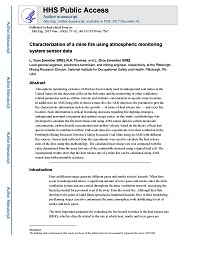Mining Publication: Characterization of a Mine Fire Using Atmospheric Monitoring System Sensor Data
Original creation date: June 2017
Authors: L Yuan, RA Thomas, L Zhou
Atmospheric monitoring systems (AMS) have been widely used in underground coal mines in the United States for the detection of fire in the belt entry and the monitoring of other ventilation-related parameters such as airflow velocity and methane concentration in specific mine locations. In addition to an AMS being able to detect a mine fire, the AMS data have the potential to provide fire characteristic information such as fire growth — in terms of heat release rate — and exact fire location. Such information is critical in making decisions regarding fire-fighting strategies, underground personnel evacuation and optimal escape routes. In this study, a methodology was developed to calculate the fire heat release rate using AMS sensor data for carbon monoxide concentration, carbon dioxide concentration and airflow velocity based on the theory of heat and species transfer in ventilation airflow. Full-scale mine fire experiments were then conducted in the Pittsburgh Mining Research Division’s Safety Research Coal Mine using an AMS with different fire sources. Sensor data collected from the experiments were used to calculate the heat release rates of the fires using this methodology. The calculated heat release rate was compared with the value determined from the mass loss rate of the combustible material using a digital load cell. The experimental results show that the heat release rate of a mine fire can be calculated using AMS sensor data with reasonable accuracy.

- Comparison of Methane Concentrations at a Simulated Coal Mine Face During Bolting
- A Comparison of Mine Fire Sensors
- Evaluation of Detection and Response Times of Fire Sensors Using an Atmospheric Monitoring System
- Evaluation of Sequential Extraction Procedures for Soluble and Insoluble Hexavalent Chromium Compounds in Workplace Air Samples
- In-Mine Evaluation of Smart Mine Fire Sensor
- Real-time method to characterize a mine fire using atmospheric monitoring systems and MFIRE 3.0
- Real-time Neural Network Application to Mine Fire - Nuisance Emissions Discrimination
- Sonic Anemometer Airflow Monitoring Technique for Use in Underground Mines
- Technology News 474 - A Passive Means to Detect Hot Trolley Insulators
- Use of Vacutainers for Collection of Mine Atmosphere Samples